Theo Verelst Local Diary Page 100
This page is copyrighted by me, and may be read and transferred by any
means only as a whole and including the references to me. I
guess that's normal, the writer can chose that of course.
Dec 28, 01:16, 2010
Page
in progress, not yet finished

Huh?
Snow, ice
Nice view, ain't it:

The big plant appears to have bowed down because of the weight of the
snow.

Server broken ?!
The old server motherboard probably didn't make it througha series of
restarts and installs because a fan on some chip on it had broken, and
wasn't accurately put on a flow of air I had improvised from a spare
fan, at least that would appear to be the reason it's broken.
This happened, and the fast notebook, after 4 years or so of farily
intinsive use, including graphics and HD TV watching for hours, doesn't
start except from low quality graphics mode anymore.
I put another machine, the one wit (HD!) sat receiver and TV digitizer,
also years in fairly intensive use, to work as a server AND HD sat
viewer, put in an extra fan, vacuum cleaned it, heatsink cleaned
it and investigaed (and talked about the price) what to do.
So:
New I7 machine, fast...

Most likely you're viewing this page being served from the machine! The
wiki is faster and possibly some page loading too, and it doesn't get
more hot. It hardly works for the internet serving and even watching HD
makes it not use more power than the old server which was based on a
3.3GHz Athlon 64.
This is what has come into being, after searching the internet for 4
seperate low price supplier of quite interesting computer parts, using
the old (ATX) enclosure and the (already years in use with the previous
server) existing 450Watt supply unit (atx 2.01), and a pretty cheap
(about 50 euro) new WD Caviar green 1 Tera Byte sata disk I had already
gotten:
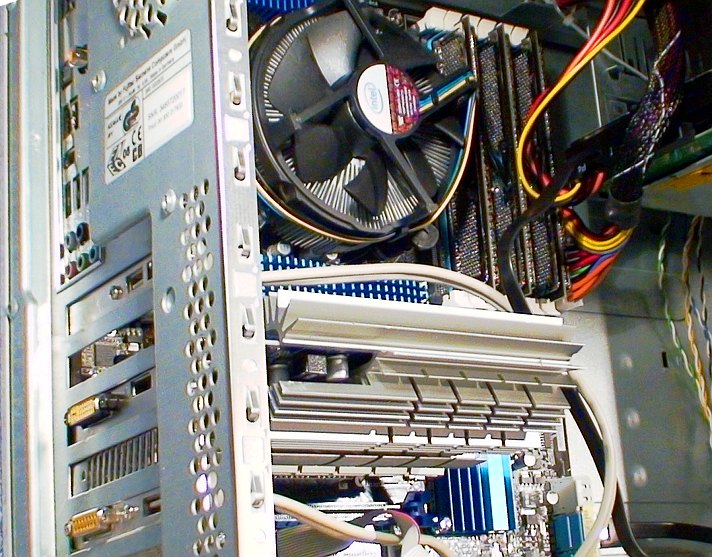
A fanless (quiet!) zodiac NVidia 930 double precision Cuda (Fermi)
capable graphics card, a I7 -950 (1366 pins, high bandwith, over 3GHz
clock), a Asus X58D-E mother board with fanless chip cooling (!...)
tripple channel memory and good tripple PCIe 2.0 connectors, and some
normal PCIs, builtin high speed Usb-3 and 6gigb/s sata raid connectors
(not used by me), as well as HD audio chip (which sound great, contrary
to any other computer audio thus far), and triple channel 1300 MHz
7-7-7-20 Ocz memory modules with integrated heatsinks and platinum
contacts (for heat flow issues).
Strangely enough even the disk light and power and reset still work in
the enclosure, and the graphics card drives a 10 meter hdmi cable with
no problems.
I put on Fedora 14 (will be a 64 bit version soon) with gnome desktop,
coming from the "install to hard disc" option from a cheap usb stick on
which I put a fedora 14 "live" version before I got the parts, which
starts up nicely when used as a boot device.
The I7 when used at the correct memory speed and latency (what does
"turn around time" mean in the Bios ?) and little higher than needed
uncore clock, and the Intel-turbo and autonatic voltage and speed
control of the asus board working is without a doubt blazing fast
(except for the "extreme" and posssibly some specific use of a Xeon or
so probably amoung the fastest pricessors in the current world), and
luckily it isn't normally as power greedy as I'd anticipated: about a
hundred wattts for the whole system at nominal speed with disc and
periphirals on when almost idle is not bad, in fact a bit less than the
previous Athlon 64 based system. With the processor going fast,
overclocling memory to 1600MHz and the bus to 3333Mhz or so, and the
graphics card working hard (its a not beastly version limited to about
50W), the power can go over 200W at least (I have to note the
powermeter isn't always reliable with computer switched supplies on it)
and easily 170 W, which is still less than the Pentium-D 3Ghz media
machine does...
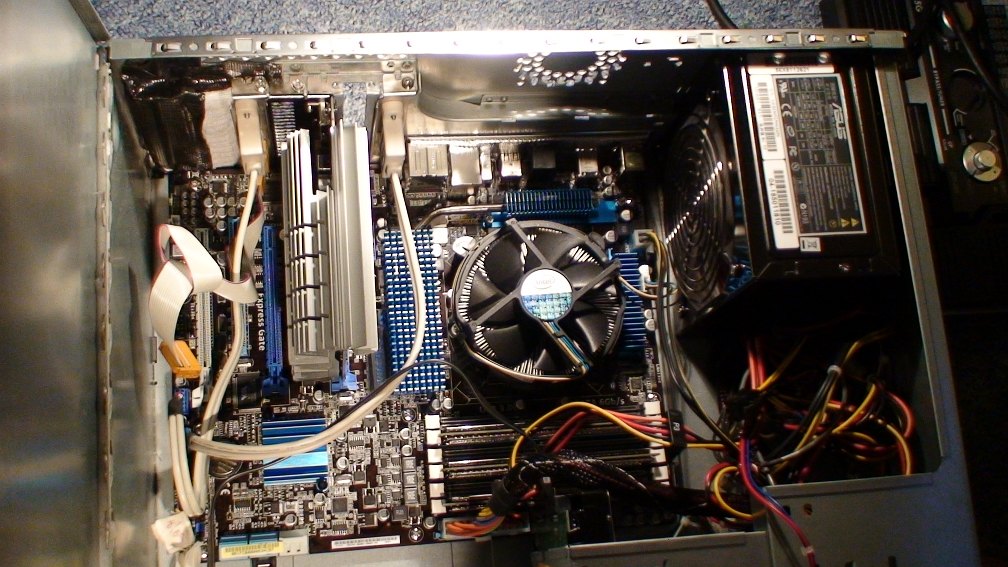
I got the nice Gnome sensor applets running telling the processor
core/thread speed amd the graphics card, processor, and mobo
temperature, the RPM of the processor fan, the core voltage, and the
measured supply voltages. All appears cool after some days continuous
use. Watching HD with VDPAU and heavy (nice !) 1920x1080 video
filtering makes the graphics card with just a big heatsink warm upt to
75 or so degrees, and depending on memory clocking and utilisation, the
processor at least was 50 so much degrees, but doing nothing heave like
now typing a page and the server runnign adn some webbroswer and so on,
the graphics card is 37 degrees (Celcius) and mobo and processor 40
degrees, and fan only 1270 RPM (Supply with big fan has no rpm sensor
connected). I didn't get under 90w.
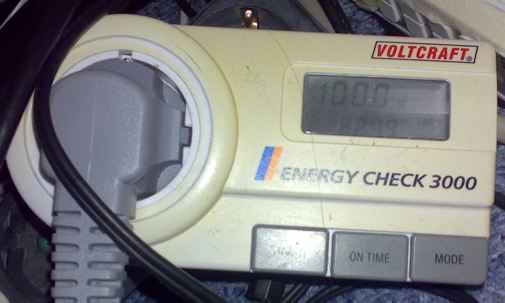
Honestly, it's not easy to really drive to processor to feel called
upon to work at much of its real potential, the main things to get it
going were the equinox 3d ray tracer and a quite rapid gaussian 32 bit
float per component (!) image filtering. Even openGL (i7) rendering of
h264 HD film didn;t really seem to make it roar it's engine, and I'm
not quite sure mplayer uses to main HD or so type of accelerator (or is
that SSE3?)!
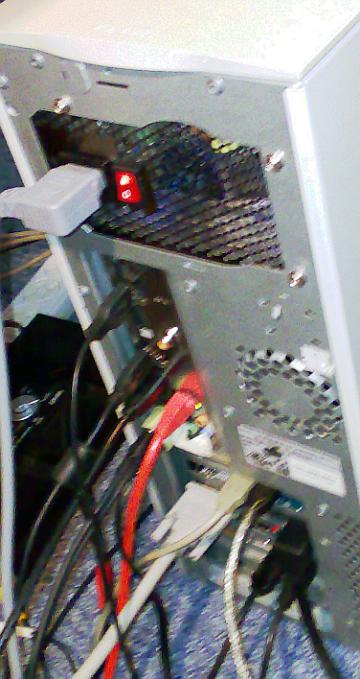
Fedora 14 on i7
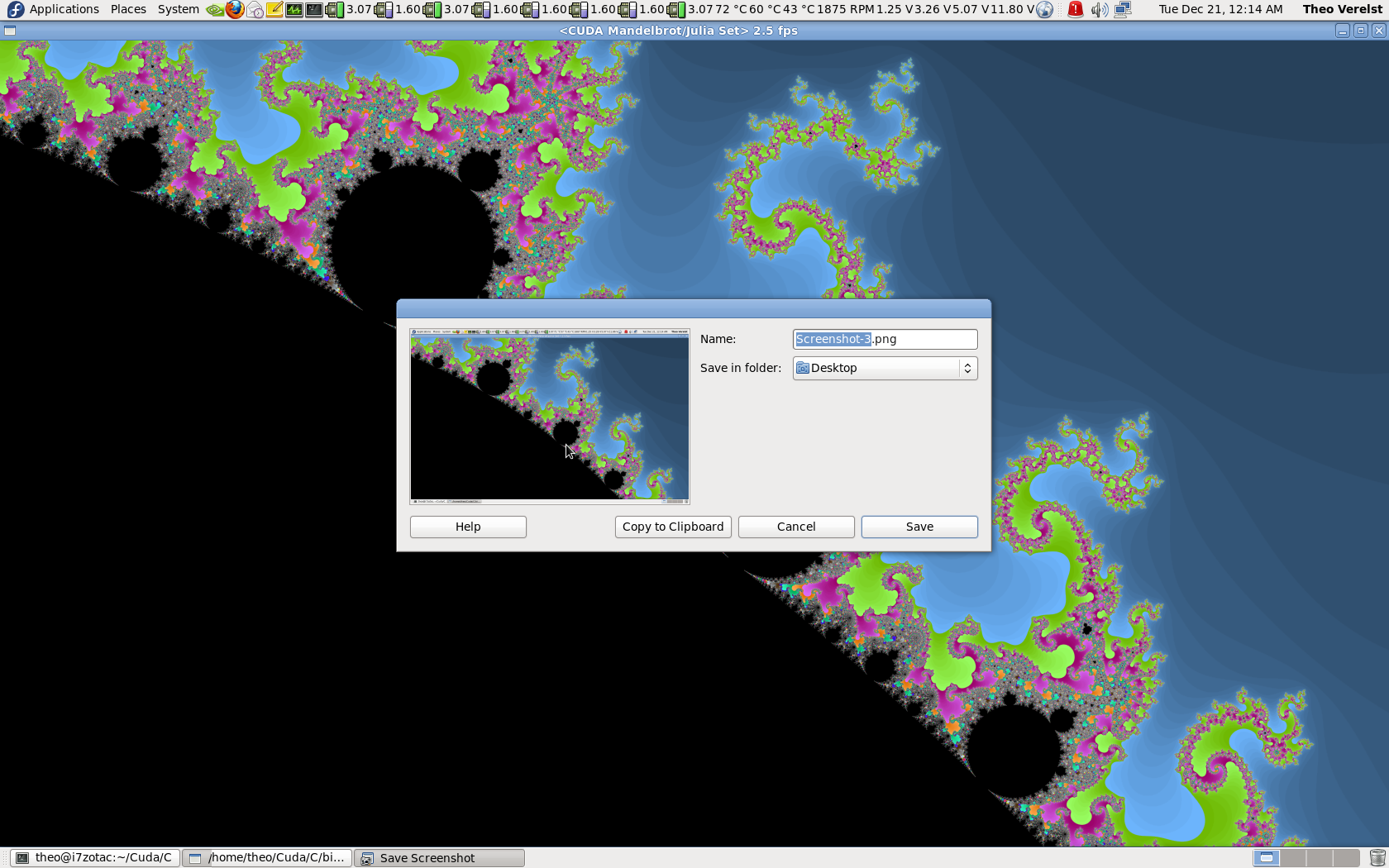
computed with actual double precision (64 bit) parallel cuda processing
but the above is on the 32 Linux version, for which some cuda examples
don't run the 64 bit Fermi (Cuda dompute 2.1 capability) parallel
computations which are quite a bit faster than the already fast
simulated ones.
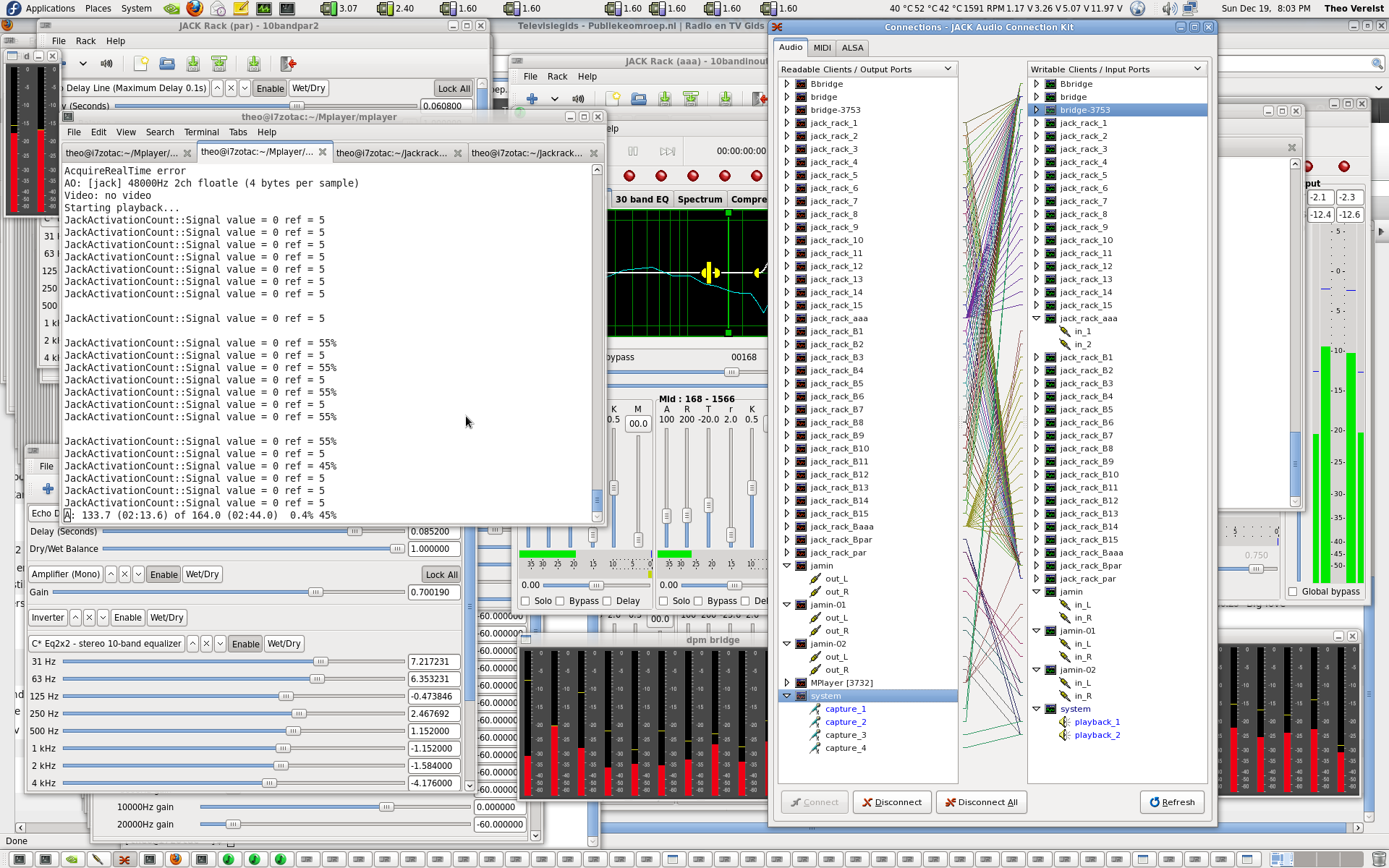
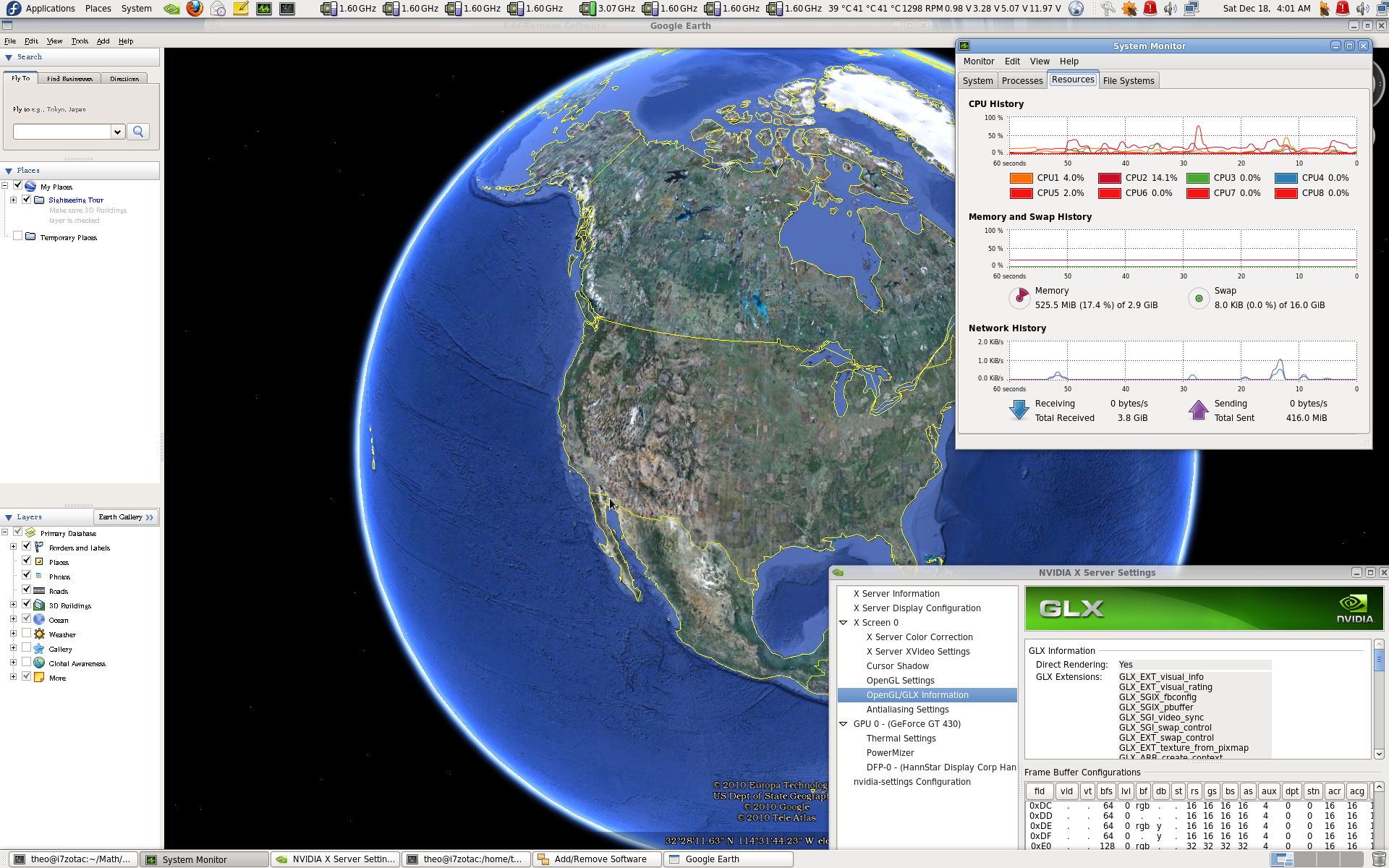
Giga ether
3d blues
New OS for the Kurzweil PC3 synthesizer
Version 2.0 is on my machine, with my sounds.
Improvements, but I need to reedit my souns from previous os.
After a little tryping out, I the sounds are better in general, with
some more space for the good type of digital tuning but some are a bit
high filtered, and I'd say only about 10 percent of the potential is
used, and my sounds (sepecially the ones I made available for
downloads) sound worked on, and throttled, and it seems they lost track
always long before I was done with my final edits on them, and like
they who made the changes to the engine don't like it, and even have
thoughts about talking back over spectrograms they can't handle and
such. What a mess.
I did try out the loading of some of the files from the Kurzweil site
for for instance the K2600. They load fine, and honestly more
than a few of the sounds, even with no sampling possibliity on
the PC3, sound quite ok and very usable and the impression most
of them give is that those programmers sure knew what they were doing
and that that works to an extend great on the PC3 architecture.
I'll have to tune my sounds of which some can sound pretty good and
varied, but I don't know when and how much I feel like that.
The definitive new Fedora 14/64bit server based on
the I7 machine
That's running now, probably where you read this www.theover.org page
from..
Not everything works easily, but knowing some things the whole
installation including wiki, including making a disk partition for
booting the Fedora installer doing an internet install (without using
DVD or Usb disk installation media) web server and web browsers, and
some more software via yum the fedora installers could be done in an
hour or so, including the downloads on a fast DASL connection (the one
I use is about 8 megabit/s effective) assuming the web server files and
the home dir with the browser and email sertting already in.
Finding it all out takes a little longer of course...
I had the server machine hardwarewise running a couple of hours after
the packages came in via the mail: 4 nice boxes from different
suppliers, all arriving after one night, most of them traceable over
the internet, and the bootable 2GB Usb stick I had prepared with Fedora
14 live image on it ran immedately without real problems.
The packages contained:
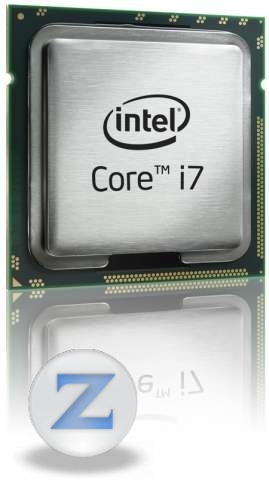 I7 from zercom
€ 250 parcel service € 5,95
I7 from zercom
€ 250 parcel service € 5,95
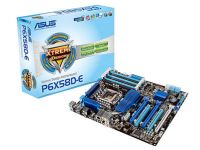 Asus P6X58D-E
iX58, SATA600 RAID, USB3.0 from 4Launch
€ 199,0 parcel service € 0,00
Asus P6X58D-E
iX58, SATA600 RAID, USB3.0 from 4Launch
€ 199,0 parcel service € 0,00
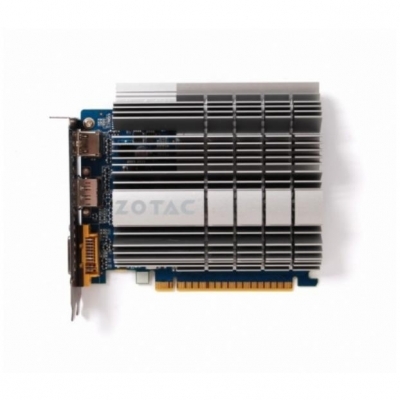 Zotac NVidia GF108
Fermi PCIe GT430 1GB "Zone" Take it Now
€ 94,90 parcel service € 0,00
Zotac NVidia GF108
Fermi PCIe GT430 1GB "Zone" Take it Now
€ 94,90 parcel service € 0,00
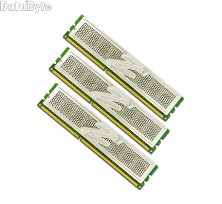 OCZ DDR3
PC3-10666 Platinum Low-Voltage Triple Ch. 3GB 1.333 GHz
(7-7-7-20) from Data Byte Shop
€ 68,53 sending € 5,-
OCZ DDR3
PC3-10666 Platinum Low-Voltage Triple Ch. 3GB 1.333 GHz
(7-7-7-20) from Data Byte Shop
€ 68,53 sending € 5,-
All was picked for and indeed arrived in one day, from the same mail
company.
I had already:
- An old (from 2001 or so) ATX metal computer case with
buttons and disk light (which lucily still works from the Sata
disk))
- a Western Digital 1 TeraByte (1000GB) Caviar Green SATA
3.5" 64MB cache disk drive (52 euro at Mycom and nowadays others)
- some usb back-plane connector plates with extnsion wires
- A 450W Asus ATX V2.01 Large fan (with nice blue leds) which
has run for 4 years continuously (24/7) already, but after opening and
vacuum dusting and a oiled fan still works OK (I just don't know it the
graphics card 12 Volt output could be added to 2 more pins of the
motherboard 12 V connector, I didn't try, now it's only got 4 out of 8
connector holes connected)
- A almost new 25 Euro wireless keyboard + precission laser
mouse from Trust
- A nice (though I prefer a bit faster and brighter) Philips
monitor working good for years already with DVI-D and VGA cables
(doesn't work on the Zotac with HDMI to DVI cable for some obscure
reason)
Luckily the software is all free (in important but pro bably not yet
all interpretations of the word, like free beer and so on) and includes:
- Gnome Desktop with special effects (but where is
ttansparenc except for window tops ?!!!
- kmod Nvidia Drivers version 260.19.29 (work with NVdia
panel and Cuda adn VDPAU)
- Apache web server + media wiki + Postgresql Database +
webserver utils for it
- Webbrowsers (Seamonkey, Firefox) Gnash (didn't work too
right) 64 bit beta version Adobe Flash plugin, Java
- Email programs: Evolution and Seamonkey
- WxMaxima with extras, scripting languages, Latex
- various Gnu CC/C++/G++/Fortan programs+libs
- Cg and various oepngl libs
- Cuda 64 bit with examples compiled and working
- NVidia's Optix (working pre-compield examples, can
compile, but results don't work yet, 32 bit version compiles working)
- A recent mplayer with various (but not all) optionals from
SVN (or GIT I don't recall) with working VDPAU and schroedinger (form
source)
- Up to date (from source) ffmpeg with schroedinger and a lot
of options (not all yet) with working multithreading (though the
-threads options seems to make little difference)
- equinox3d with examples compiled and Cg running,
working Blender (precompiled)
- Krita (koffice), nip2, Gimp, Qtpfsgui, fast working
compiled from source Jasper
- Games: Alien Arena, Freedoom, Liquid War, Thunder and
Lightning...
- Audio: pulsetools (why is pulse part of gnome and not a
normal deamon ?) alsatools (alsamixer recognizes all soundchip channels
it seems but I'm working on more than a stereo input pair and
possibly digital input)
- Jack-rack, most jack-plugins, working Jamin, rosegarden,
Linuxsampler
- athlon-64 compield Dune version for (Working) pinnacle
Deluxe usb TV, tcl scripts to get live HD (ITV1-HD) sat signal over the
gigaether hub from antoher machine
- Working Google-earth 6 (beta or so) with trees as 3D models
(at least in San Fransisco)), no crashes after install blues was over...
Overclocking ?
Uuuuhm, well at the moment the BIOS settings are quite like how I
started them: almost everything on "auto" about voltages, frequencies
and multiplier factors, and even tranmission properties. I tried the
official memory settings (1333 MHz, 7-7-7-20 latency), even a faster
setting (1600, 9-9-9-24, I don't know if the latency should scale, but
I suppose so) explicit XMOP (or whatever the right acronym is), various
Quick PointToPoint Link settings (left it at the max: 6400MB/s), fan
settings preferably "medium" colling program (some settings it gets
stuck at 2000 RPM, bit noisy setting) and I experimented and looked up
some other settings (and of course set the disk and boot parameters).
In the end, only automatic setting thus far gives normal enough
behviour, and the whole doesn't respond right to setting the ram faster
without setting more parameters, and I didn't yet to manually setting
the bus voltages and such, because when used wrong, these could
absolutely break (for my current life) expensive parts like the I7. I
would like to use the memory are 1.6 GHz though, and the core probably
*can* run even over 4GHz even with the standard cooler, which for
peak-capacity challenging too...
All the meters oof the linux sensors package thus far appear to work
reliable: evey two seconds I get most the important measurements
updated on top of the screen, and at night I fix theprocessor
speeds at the lowers setting, so even full use of all the cores
by the web server doesn't take too much power or heat.
As it is, the machine can be heavily mulit-threading transcoding h264
to .mks format at 6 frames per second while playing HD video with
software decoding from schroedinger (Dirac, the BBC wavelett codec)
with graphics card acceleration for image improvements (VDPAU flter),
and meanwhile run a webbrowser and let Google-Earth run into swap space
(there's 16 Gig of that and 3 Gig of main mem) while downloading a
megabyte per second sustained with the webserver running in the
meanwhile, without any problems of doing that quite a while. Powe use?
About 215 watts in that case.
Is it possible to get close to the real power of the machine's
processor anyhow? Besides the above test, the equinox3d program for 3D
graphics rendering has a software ray-tracer next to a "normal" opengl
accelerated pipeline and a great Cg based frame-rate renderer which can
draw a lot of the juice from the 8 I7 threads simultaneously. and get a
very fast image with radiosity (even scientifically tested) and ray
tracing effects as such:
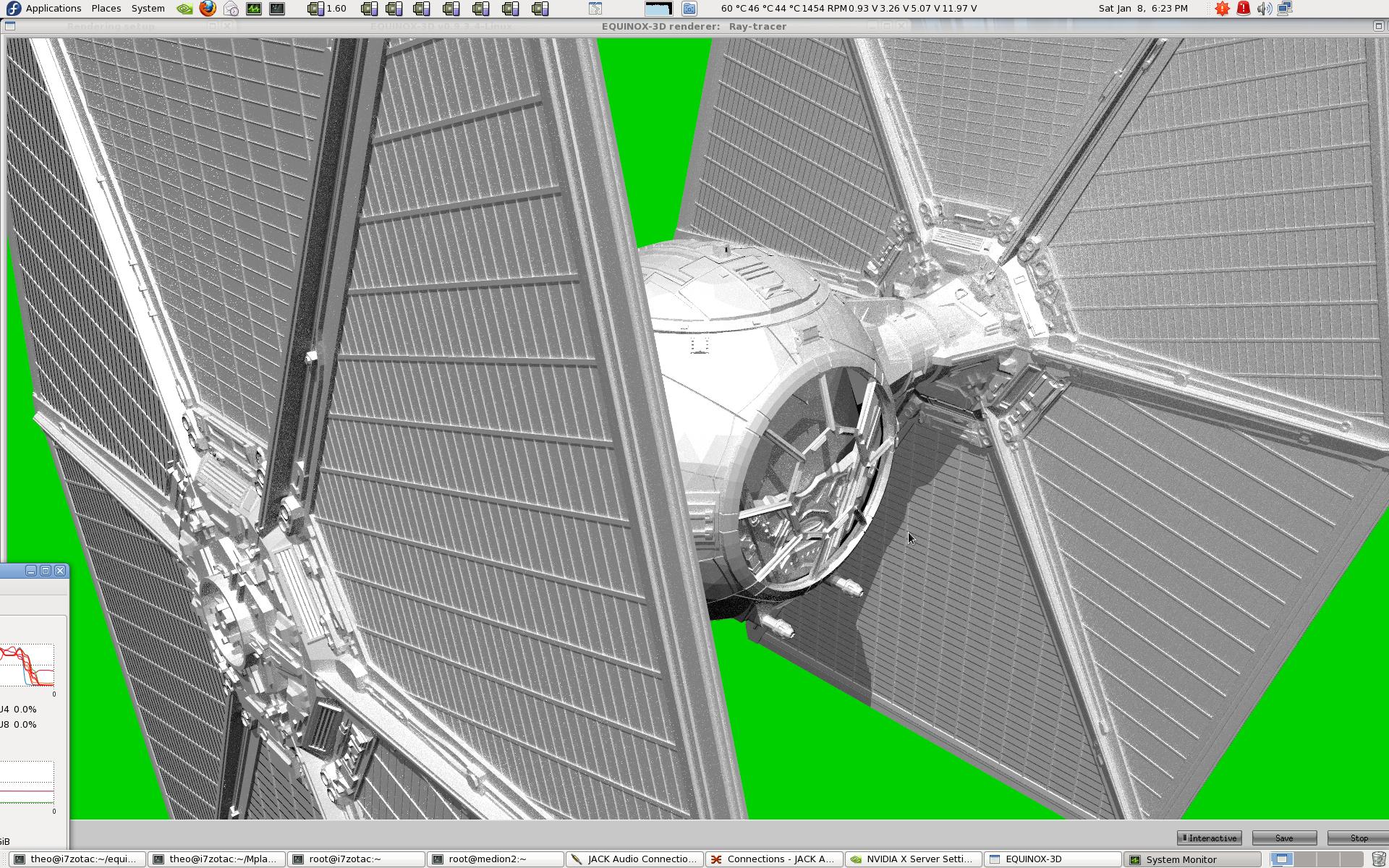
Probably under a minute rendering.
There are NVidia opverclocl utilities I can yum-in, I didn't try, and
the fanless card might not be the most excellent candidate for that...
In this case the adaptive clocking taking the used power down during
server-olny operation is more interesting me.
The Fermi doubl-precision computation power is pretty cool though, if
the nbody Cuda-64 example doesn't lie, it gets a whopping enough
> 12 Giga Double precision-Floating
point computations per second
out of the cuda machinery, sustained and measured in practice that is.
Should be cool for accurate audio, too.
Can the ultimate suffer more accessories?
This a great possibility of the still not expensive kind:
 from Mycom:
€ 192,-
from Mycom:
€ 192,-
about 500 Megabyte per second fills a PCIexpress slot nicely with .1 ms
latency, only 50GigaByte makes it affordable for storing frames
and playing like 16 bits per RGBA component back over opengl or so. Are
there already SSE4 programs ? The gnu compiler seems to support them
(like max computations for HD).
 from Mycom
€ 110,-
from Mycom
€ 110,-
60 GB almost 300MB/s transfer speed (minus maybe some more) good for
frames and Linux-/Gigasampler sample files and possibly startup
executables and/or web pages and scripts to put the main disk in
standby during the night and "server only" hours.
An extreme I7 of higher frequency and 1.5 more cores wouldn't be bad.
Of course with a 1000 Watt supply (which the motheboard supports)
tripple SLI graphics cards with even heavier processors wouldn't be bad
experiment!
Two (or even 4 if that's possible) Western Digital Caviar drives in
RAID fashion, a 1.5 Terabyte one costs only about 70 euro a piece. Are
there already Sata 6Mb/sec drives of some kind ?
A bluray reader or burner, there appear to be Linux possibiities to
write discs and at least some amount of Linux Mplayer playing of
Blurays is possible.
Sat receiver for S2 type signals (exists and no too expensive but I'm
not sure Linux support) , I have already a "normal" HD sat machine, but
the card is probably a special type of PCI card.
A UPS could be cool, though recently the (previous) server could run
for months (without a restart except for the X server) without problems.
An extra case fan is needed for heavy graphics/Cuda and some
motherboard cooling and in the long run keeping the disk cool for
certain maybe. and some 3.5 mm (mini) jack to 1/4" jack would be nice
to use the inputs and outputs of the graphics card.
Aes meeting
I was here: 'Luidheidsnormalisatie
volgens EBU R128'
Eelco Grim - Richard van Everdingen
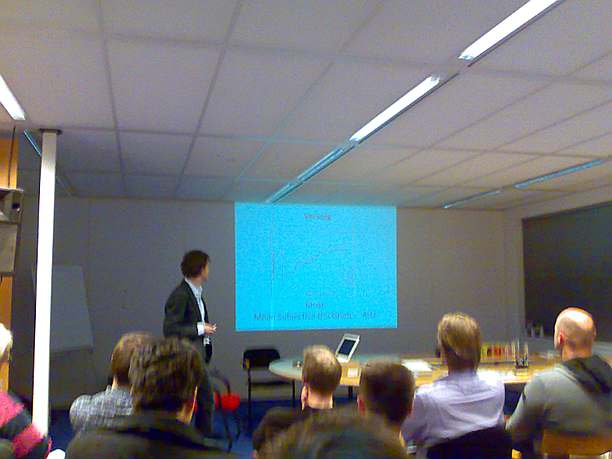
I think the subject was covered alread in the 50s,
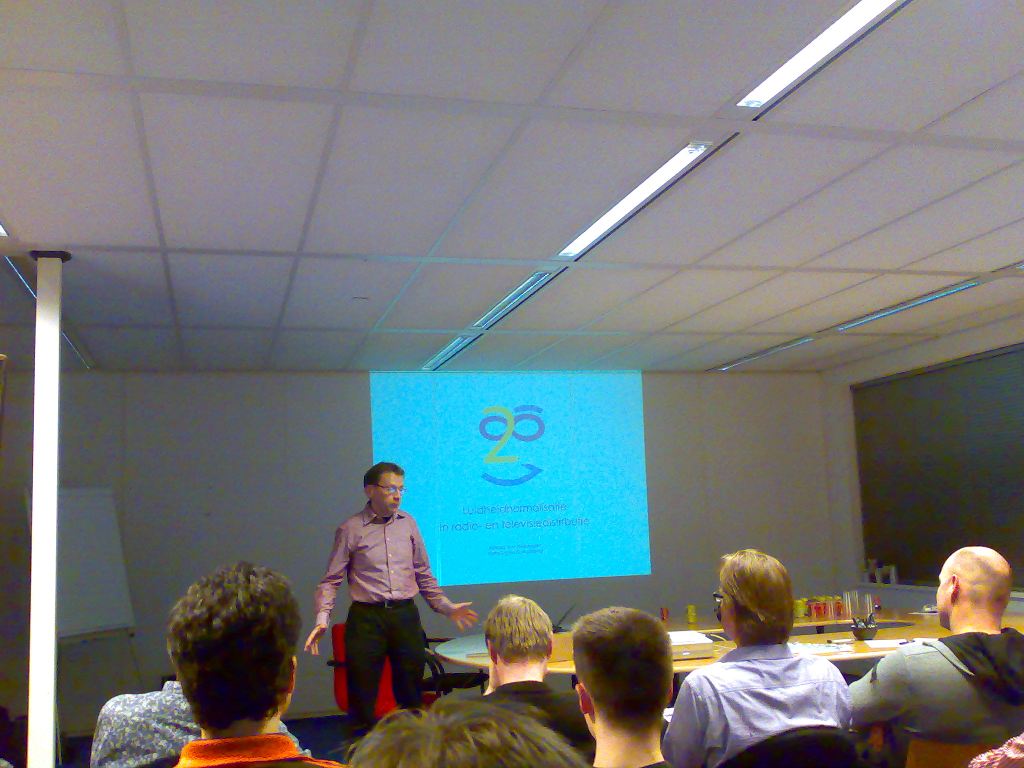
but I suppose the observed loudness differences in the cable TV area
speak about some serious matters.
My reading materials

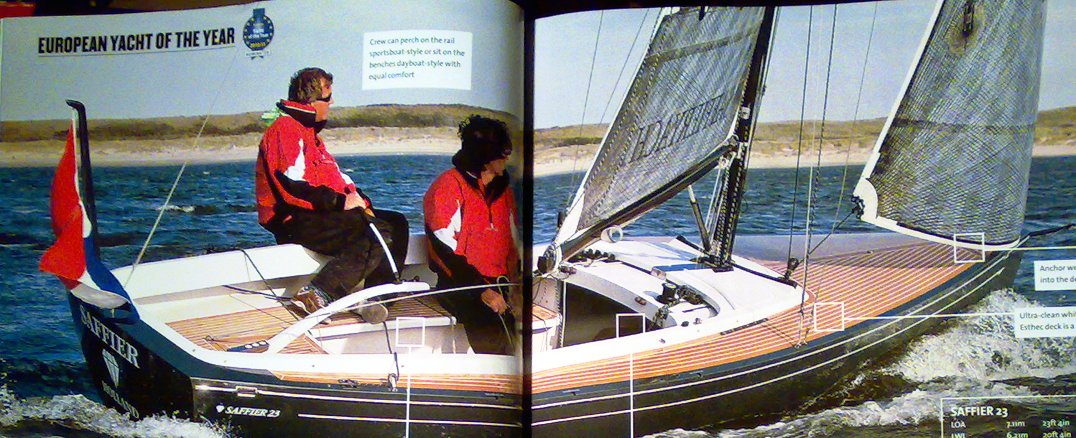
nice shape. Can I go US though ?
A digitizer on Linux
I finally got the Aiptec digitizer tablet from Conrad from years ago
working in pressure sensitive mode, except the nicest brusing program
*with* 16 or more bits per RGB component doesn't work at all on 64 bit
Fedora.
I wouldn't call it an abstract work much (I can know, I did more than a
few years of art academy drawing practice), more like trying out the
various effects on GIMP (which works reliable, except mouse + digitizer
is sometimes hard):

With some processing and more scetchy stripes this small image (really,
sometimes I don't work in HD..) it turned to this:

I can't help feeling like with sytnhesizers, digitizer tablets are
mofo-ed too to behave not faster and more free than necessary for some
poeples' needs.
"You have to believe we are magic"
I don't care what I've been told. Eskimo pussy.. etc.












 I7 from zercom
€ 250 parcel service € 5,95
I7 from zercom
€ 250 parcel service € 5,95 Asus P6X58D-E
iX58, SATA600 RAID, USB3.0 from 4Launch
€ 199,0 parcel service € 0,00
Asus P6X58D-E
iX58, SATA600 RAID, USB3.0 from 4Launch
€ 199,0 parcel service € 0,00 Zotac NVidia GF108
Fermi PCIe GT430 1GB "Zone" Take it Now
€ 94,90 parcel service € 0,00
Zotac NVidia GF108
Fermi PCIe GT430 1GB "Zone" Take it Now
€ 94,90 parcel service € 0,00 OCZ DDR3
PC3-10666 Platinum Low-Voltage Triple Ch. 3GB 1.333 GHz
(7-7-7-20) from Data Byte Shop
€ 68,53 sending € 5,-
OCZ DDR3
PC3-10666 Platinum Low-Voltage Triple Ch. 3GB 1.333 GHz
(7-7-7-20) from Data Byte Shop
€ 68,53 sending € 5,-
 from Mycom:
€ 192,-
from Mycom:
€ 192,- from Mycom
€ 110,-
from Mycom
€ 110,-




